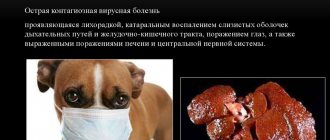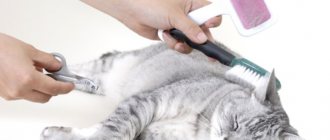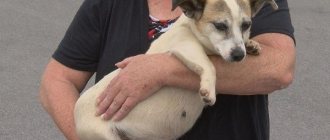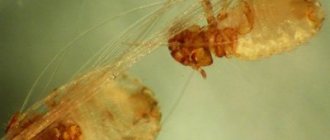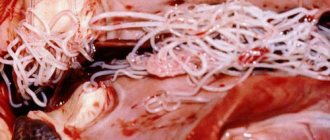Discopathy in dogs is degenerative changes in the tissue between the vertebrae, due to which the disc becomes less elastic and ceases to perform a shock-absorbing function. It is most often detected in diseases of the pet’s spine. Usually the following symptoms are added to it: limitation of movements of the paws and parts of the spine, pain. Doctors note that the earlier the disease is detected, the faster the functioning of the spine can be restored. What does this disease entail, what are the symptoms and treatment of spinal gait in dogs.
The essence of the disease
Disc composition: annulus fibrosus and gel-like core. It plays a shock-absorbing role and prevents the vertebrae from rubbing against each other. If there are problems with the pet’s water-salt metabolism, the nutrition of the discs deteriorates. Their tissues become harder, more fragile and porous, and under the pressure of the vertebrae they become completely flattened.
Further violations are divided into two main groups:
- Extrusions in which the disc ruptures and the nucleus leaks out into the medullary canal.
- With protrusions, the intervertebral discs are compressed and pressure occurs on the spinal cord, followed by swelling.
Discopathy is the main cause of intervertebral hernia. This pathology is common among dachshunds, pugs, spaniels and other small breeds. Among large breeds of pets, there are disc displacements, but the tissue of the fibrous ring does not undergo changes. The bulk of the sick are animals from three to eight years old.
Causes
Chondrodystrophoid dog breeds - dachshunds, pugs, bulldogs, Pekingese - are prone to discopathy. Dachshunds are at greater risk for this disease. In more than 60% of cases, discopathy is observed in dogs of this breed.
Dogs aged 4 to 7 years are most often affected. Predisposing factors of the pathology are obesity and other metabolic disorders. Less commonly, pathology occurs after spinal injury.
The main cause-and-effect factor in the development of discopathy is cartilaginous metaplasia. The process refers to forms of pathological regeneration, when tissue of one type is replaced by another. This is how fibrous tissue is replaced with cartilage or bone.
Metaplasia develops against the background of chronic inflammation, tissue nutrition or metabolism.
Symptoms
In the first stages, the symptoms of the pathology are not immediately noticeable or begin and pass quickly, occurring periodically. The dog may suffer from cervical pain, so every movement of its head causes pain to it and it tries not to do it again. The animal can walk, slightly bending its paws at the knees, pain begins in the lumbar region. This can be seen by the way the dog refuses to sit down and does not allow himself to be stroked on the back. And while sitting or lying down, when suddenly standing up or jumping from a place, the pet squeals in pain. His peritoneum is tense, and thoracolumbar kyphosis develops with visually noticeable hunching.
When you try to pet the dog, he sometimes reacts with aggression. The dog tries to relieve the discomfort as much as possible by moving less. There is pain when defecating and urinating. It can drag one of the limbs when moving, as with osteochondrosis. The pet's gait becomes unnatural and very rigid, and the usual depreciation is not observed. He often trembles, tail spasms begin, and coordination of movements is impaired.
As the disease progresses, there may be paralysis of the limbs. This especially often develops after a walk or prolonged physical activity. For example, the owner ordered to bring a stick and the pet jumped and fell to the ground squealing and howling in pain.
If a dog was injured by an object while walking, hit, knocked down, or in other cases of mechanical impact, this does not apply to degenerative changes in the intervertebral disc. The pathology develops gradually.
Prevention
Prevention of the spread of discopathy among purebred dogs is carried out through culling and preventing diseased individuals from breeding.
Due to the fact that mating begins in animals that have reached the age of 1.5-2 years, the disease is established later than the appearance of the first litters. Taking into account heredity, it can be recommended not to allow puppies from parents who have symptoms of discopathy into breeding. Losing excess weight and combating a sedentary lifestyle is the second most important disease prevention. Increased body weight creates a significant load on the structure of the vertebrae, forcing it to bend. Timely consultation with a doctor at a stage when the manifestations of the disease are still weakly expressed makes it possible to stop its development in 90% of cases.
Why does discopathy occur in dogs?
Veterinarians say that the causes of the disease may be different.
For example:
- Problems with water-salt balance.
- Predisposition of certain breeds. Dachshunds are especially susceptible to this disease. Almost half of dachshunds have a similar disease to one degree or another throughout their lives.
- Excess weight.
- Age. Most often, the disease is recorded in pets from 3 to 8 years old, but this does not mean that a one-year-old dog cannot develop discopathy.
- Hair loss.
- Severe obesity.
How to diagnose pathology?
The sooner the owner notices unpleasant symptoms, the greater the likelihood of maximizing the pet’s health. Remember that degenerative processes in this disease are irreversible.
Examination at the doctor's office
The doctor examines the dog for the ability to move, jump, and walk up stairs. When diagnosing, it is important to evaluate the activation of reflexes (decreased or accelerated), this way you can understand how damaged the spinal cord is. The doctor looks at the sensitivity of the limbs to pain by testing the animal with a needle holder. If it simply withdraws its paws, then problems with the nerve endings begin. If an emotional component is added (whining, aggression, fear), then the nerve endings are not damaged.
If the paws do not completely feel the doctor’s manipulations, then urgent surgical intervention is necessary, provided that twelve hours have not passed since the time of paralysis. If more time has passed, then the prognosis is unfavorable.
Diagnostics using medical equipment
After the veterinarian examines the dog, it is time to diagnose the disease with an x-ray. This method helps to identify diseases of the musculoskeletal system, but does not make it possible to understand how deformed the disc is.
It is possible to perform myelography, when a colored substance based on iodine is injected into the neck or lower back. This technique helps to understand how severe the damage to the spinal cord is, where the damaged area is located.
One of the most modern methods is the use of MRI. It has no contraindications, and the diagnosis itself gives the doctor an understanding of the processes occurring in the tissues of the spine.
Recovery prognosis
The prognosis for animals affected by discospondylitis depends on the underlying cause of the infection. Bacterial can be treated quite well. But brucellosis infection cannot be completely cured, so most dogs with this type of infection are prescribed lifelong antibiotic therapy. Fungal discospondylitis has the worst prognosis. Such a disease will worsen from time to time, regardless of how well the treatment was carried out.
Physical rehabilitation is also useful in helping an animal recover from illness. He needs to maintain muscle mass and joint flexibility.
This is achieved using:
- massage;
- thermotherapy;
- neuromuscular electrical stimulation.
Types of disease
Another name for the pathology is Hansen's disease. It is divided into two main types, depending on the mechanism of the pathology. All types of disease cause degeneration.
First view. The dog experiences disorders that subsequently develop; the outer layer of the discs is destroyed, and the inner layer, on the contrary, becomes denser. The outer shell ruptures, and the inner layer puts pressure on the spinal cord, the inflammatory process begins and clamps on the nerve endings. The pathology develops quickly and is often diagnosed in dogs under 3 years of age with short limbs (poodles, bulldogs, lapdogs). With this type, severe pain develops.
The second type of disease develops more slowly, with severe compression of the spinal cord and its gradual destruction. Typically occurring in older animals, it does not cause as much discomfort as type 1 disease and involves one or two vertebrae.
Diagnosis of the disease
To make a correct diagnosis, the veterinarian conducts a number of studies:
- Analysis of biochemical blood parameters.
- General analysis.
- Neurological tests:
- with a calm step, the doctor assesses the position of the animal’s head, back, limbs, and the tone of its muscles;
- the ability to run, jump, climb up and down from elevated positions is assessed;
- reflexes are checked;
- the pain threshold is examined by pinching the skin between the phalanges of the fingers, while the dog must withdraw its paw and bite; if it only whines, this means that sensitivity is reduced.
- An X-ray of the spine will show the location of the lesion and its extent. When a contrast agent is injected under the meninges, the X-ray result will be as reliable as possible.
- An MRI or CT scan is the most accurate diagnostic method, but is not available in all clinics and is quite expensive.
In addition to tests and instrumental studies, the veterinarian will ask the owner in detail about the symptoms that the dog has, and by combining all the results obtained, he will be able to make the correct diagnosis.
Treatment of the disease
What methods are used to treat pets?
- If the clinical picture reveals only the presence of pain and discomfort, and the dog’s limbs do not lose sensitivity, then doctors prescribe treatment with non-steroids. For example, Rimadyl or ketofen.
- During drug treatment, the pet needs rest and limited mobility for up to a month. This technique is not suitable for dogs whose neck is affected. These pets have severe pain without loss of sensitivity in the limbs, but the discomfort begins again as soon as the effect of the medications stops.
- When a dog experiences very severe pain attacks accompanied by neurological symptoms, it needs to be operated on, removing the disc and stopping the compression of the spinal cord. The operation can be performed using the ventral slits technique, laminectomy, hemilaminectomy, etc.
- After surgery, the pet is recommended to take a course of antibacterial drugs.
- The recovery period includes massage, swimming, stimulation of the affected area with electric current, reflexology, etc. The recovery course is developed individually.
Should I have surgery or not?
If your pet is in pain and the pathology is just beginning, then it is better to treat the dog with medications prescribed by a doctor. But the veterinarian will not be able to guarantee that degenerative disorders will not begin again. During this period, it is important to immobilize the pet so as not to provoke prolapse of the disc nucleus. When is it urgent to operate on an animal? If they lose sensitivity or paralysis of the limbs occurs; pain does not decrease after medication; cervical pain.
It is important not only to operate on the dog, but also to eliminate the hernia so that the pet does not remain disabled. This also applies to inguinal hernias.
When the spinal cord is compressed, disturbances in blood flow to the affected area and its nutrition with useful substances begin. If the brain is under constant compression, the consequences become irreversible. In cases where the operation was performed within two days after the onset of sharp compression, it is possible to restore the function of the pet’s spinal cord.
When treating an animal with medications aimed at relieving swelling of the spinal cord, they help eliminate neurological symptoms. And the dropped disc does not move back. The swelling subsides and the compression is repeated, becoming even stronger, which leads to more disastrous consequences. This treatment method is very risky and its effectiveness has not been proven.
There are a number of statements from owners who say that they cured their dog with homeopathic medicines. But, according to doctors, such cases have nothing to do with the effect of the drugs themselves. After all, the usual immobilization of a pet also gives temporary effectiveness without a course of medication. Swelling is reduced, sensitivity is restored, but in the long term this method does not have positive dynamics.
According to statistical data, the best treatment results were observed in those pets who underwent surgery on time. Therefore, do not hesitate; the sooner you contact a veterinarian, the greater the chances of curing your furry pet.
Currently reading:
- Thyroid dysfunction in dogs (hypothyroidism)
- Caring for a Dog with Degenerative Myelopathy
- Actions to take in case of an epileptic attack and a shaking dog
- Pinched nerves and subtle symptoms in dogs
Diet and care
During rehabilitation, the dog is put on a diet, limiting its fat intake. To improve metabolism and stimulate nerve impulses, B vitamins are added to the diet.
On average, recovery takes 1-1.5 months. All this time you need to stay close to the animal. If he is completely paralyzed, he will have to change his diapers and turn him over periodically. Changing positions will help avoid the formation of bedsores. If such care is difficult due to work, arrange to place the dog in a hospital.
In the first days of treatment, activity is reduced to a minimum. After the condition has stabilized and acute symptoms have subsided, physiotherapy is prescribed.
At first, the animal is forced to move around using a stroller. After regularly performing reflex walking exercises, limb mobility returns.
Full walks are returned only after receiving appropriate permission from a doctor. At home and on the street, the operated pet will have to walk in a special corset that fixes the position of the spine. Without it, the discs may become misaligned again.
